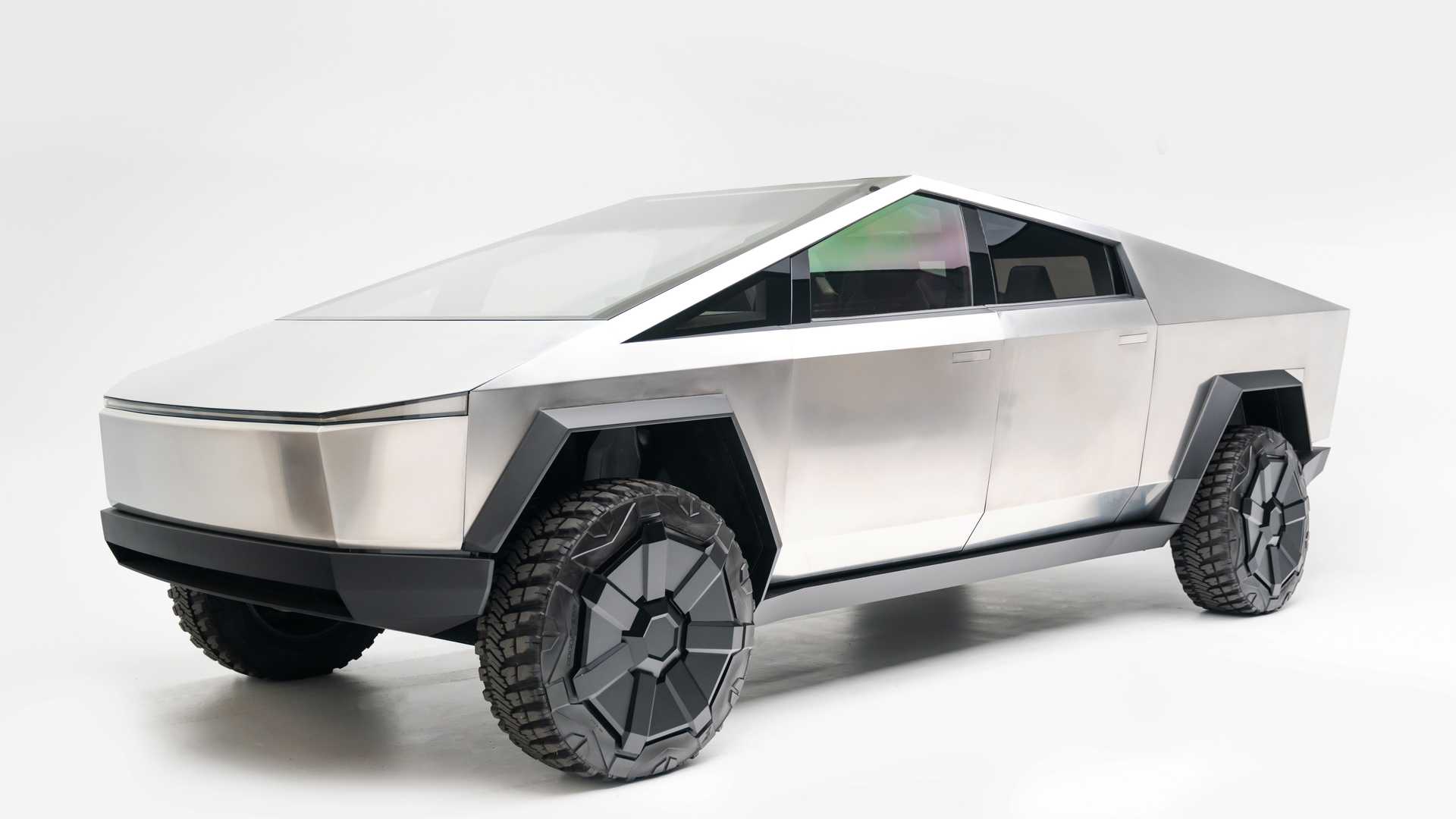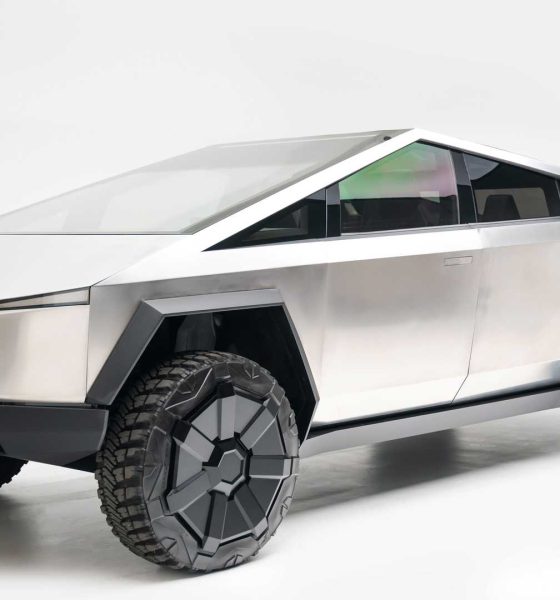Tesla already has a full plate for 2023. Even without the Q4 2022 delivery numbers, the company aims to grow another 50% this year. Below are just a few of Tesla’s biggest goals in 2023.
Tesla Cybertruck Production
Tesla also aims to start the Cybertruck’s initial production at Giga Texas, and might deliver a few Cybertrucks by the end of the year. The company will probably concentrate on Cybertruck production this year, with first deliveries likely starting in the second half.
Cybertruck bodies were spotted at Tesla’s Texas HQ in the weeks leading up to the new year. In early December, a Cybertruck rear megacast was seen at Giga Texas. Later that same month, equipment for the Cybertruck assembly line also started arriving at the Texas HQ.
The EV manufacturer might also be working on a smaller two-door Cybertruck concept. However, it will likely focus on the Cybertruck that it unveiled a few years ago.
Tesla Model 3 Revamp
First on Tesla’s list is the Model 3 revamp, otherwise known as “Project Highland.” The revamped Model 3 is expected to introduce updates to the all-electric sedan’s interior, infotainment system, and other crucial features.
People familiar with the Project Highland noted that Tesla managed to decrease the Model 3’s components. The revamped Model 3 would also get a better display. At the Q3 2022 earnings call, Elon Musk noted that next-generation Tesla vehicles might utilize the company’s smaller platform.
“But at this point, we’ve done the engineering for Cybertrucks and for Semi. So, it’s obviously against what we’re working on, which is the next-generation vehicle, which will be probably about the cost of 3 and Y platform. It will be smaller, to be clear,” Musk said.
Tesla Gigafactories and Other Projects
Tesla is still ramping up production at Giga Texas, Giga Berlin, and its Megafactory. The company’s other factories, including the Fremont Factory, Giga Nevada, and Giga Shanghai, will likely continue to improve and grow.
Tesla is also expected to announce the location of its next gigafactory. The top contenders seem to be Mexico, Canada, Indonesia, and South Korea.
Besides the Model 3—and possibly work on the company’s smaller vehicle—and the start of Cybertruck production, Tesla is also ramping Semi production. So the company’s gigafactories will be plenty busy year-round.
Tesla China’s Big Boss Gets Bigger Role
Elon Musk may also give Tesla China boss Tom Zhu more responsibilities at the company, which would be a big transition for Tesla. Zhu is expected to take on a bigger role in Tesla as its new Global Operations manager, as per previous reports.
Tesla has not confirmed Zhu’s new role at the company, but he has already stepped down as Tesla China’s main legal representative and some people have bid farewell to him on Weibo.
Zhu and his team of engineers from China have been spending time at the Fremont Factory and Giga Texas. They have also allegedly been working closely on Cybertruck production preparations.
Tesla still has a bunch of products in development, like the Roadster and the humanoid robot Optimus. Plus, Tesla has yet to officially unveil its $25,000 vehicle, dubbed by some in the EV community as the Model 2. Then there are updates for Full Self-Driving and Autopilot and 4680 production. As 2023 continues, Tesla will likely add more events to its packed schedule.
I’d appreciate tips about any of the projects mentioned in this article. Contact me at maria@teslarati.com or via Twitter @Writer_01001101.

News
Tesla FSD v14.2.2 is getting rave reviews from drivers
So far, early testers have reported buttery-smooth drives with confident performance, even at night or on twisty roads.

Tesla Full Self-Driving (Supervised) v14.2.2 is receiving positive reviews from owners, with several drivers praising the build’s lack of hesitation during lane changes and its smoother decision-making, among others.
The update, which started rolling out on Monday, also adds features like dynamic arrival pin adjustment. So far, early testers have reported buttery-smooth drives with confident performance, even at night or on twisty roads.
Owners highlight major improvements
Longtime Tesla owner and FSD user @BLKMDL3 shared a detailed 10-hour impression of FSD v14.2.2, noting that the system exhibited “zero lane change hesitation” and “extremely refined” lane choices. He praised Mad Max mode’s performance, stellar parking in locations including ticket dispensers, and impressive canyon runs even in dark conditions.
Fellow FSD user Dan Burkland reported an hour of FSD v14.2.2’s nighttime driving with “zero hesitations” and “buttery smooth” confidence reminiscent of Robotaxi rides in areas such as Austin, Texas. Veteran FSD user Whole Mars Catalog also demonstrated voice navigation via Grok, while Tesla owner Devin Olsen completed a nearly two-hour drive with FSD v14.2.2 in heavy traffic and rain with strong performance.
Closer to unsupervised
FSD has been receiving rave reviews, even from Tesla’s competitors. Xpeng CEO He Xiaopeng, for one, offered fresh praise for FSD v14.2 after visiting Silicon Valley. Following extended test drives of Tesla vehicles running the latest FSD software, He stated that the system has made major strides, reinforcing his view that Tesla’s approach to autonomy is indeed the proper path towards autonomy.
According to He, Tesla’s FSD has evolved from a smooth Level 2 advanced driver assistance system into what he described as a “near-Level 4” experience in terms of capabilities. While acknowledging that areas of improvement are still present, the Xpeng CEO stated that FSD’s current iteration significantly surpasses last year’s capabilities. He also reiterated his belief that Tesla’s strategy of using the same autonomous software and hardware architecture across private vehicles and robotaxis is the right long-term approach, as it would allow users to bypass intermediate autonomy stages and move closer to Level 4 functionality.
News
Elon Musk’s Grok AI to be used in U.S. War Department’s bespoke AI platform
The partnership aims to provide advanced capabilities to 3 million military and civilian personnel.

The U.S. Department of War announced Monday an agreement with Elon Musk’s xAI to embed the company’s frontier artificial intelligence systems, powered by the Grok family of models, into the department’s bespoke AI platform GenAI.mil.
The partnership aims to provide advanced capabilities to 3 million military and civilian personnel, with initial deployment targeted for early 2026 at Impact Level 5 (IL5) for secure handling of Controlled Unclassified Information.
xAI Integration
As noted by the War Department’s press release, GenAI.mil, its bespoke AI platform, will gain xAI for the Government’s suite of tools, which enable real-time global insights from the X platform for “decisive information advantage.” The rollout builds on xAI’s July launch of products for U.S. government customers, including federal, state, local, and national security use cases.
“Targeted for initial deployment in early 2026, this integration will allow all military and civilian personnel to use xAI’s capabilities at Impact Level 5 (IL5), enabling the secure handling of Controlled Unclassified Information (CUI) in daily workflows. Users will also gain access to real‑time global insights from the X platform, providing War Department personnel with a decisive information advantage,” the Department of War wrote in a press release.
Strategic advantages
The deal marks another step in the Department of War’s efforts to use cutting-edge AI in its operations. xAI, for its part, highlighted that its tools can support administrative tasks at the federal, state and local levels, as well as “critical mission use cases” at the front line of military operations.
“The War Department will continue scaling an AI ecosystem built for speed, security, and decision superiority. Newly IL5-certified capabilities will empower every aspect of the Department’s workforce, turning AI into a daily operational asset. This announcement marks another milestone in America’s AI revolution, and the War Department is driving that momentum forward,” the War Department noted.
News
Tesla FSD (Supervised) v14.2.2 starts rolling out
The update focuses on smoother real-world performance, better obstacle awareness, and precise end-of-trip routing, among other improvements.

Tesla has started rolling out Full Self-Driving (Supervised) v14.2.2, bringing further refinements to its most advanced driver-assist system. The new FSD update focuses on smoother real-world performance, better obstacle awareness, and precise end-of-trip routing, among other improvements.
Key FSD v14.2.2 improvements
As noted by Not a Tesla App, FSD v14.2.2 upgrades the vision encoder neural network with higher resolution features, enhancing detection of emergency vehicles, road obstacles, and human gestures. New Arrival Options let users select preferred drop-off styles, such as Parking Lot, Street, Driveway, Parking Garage, or Curbside, with the navigation pin automatically adjusting to the user’s ideal spot for precision.
Other additions include pulling over for emergency vehicles, real-time vision-based detours for blocked roads, improved gate and debris handling, and extreme Speed Profiles for customized driving styles. Reliability gains cover fault recovery, residue alerts on the windshield, and automatic narrow-field camera washing for new 2026 Model Y units.
FSD v14.2.2 also boosts unprotected turns, lane changes, cut-ins, and school bus scenarios, among other things. Tesla also noted that users’ FSD statistics will be saved under Controls > Autopilot, which should help drivers easily view how much they are using FSD in their daily drives.
Key FSD v14.2.2 release notes
Full Self-Driving (Supervised) v14.2.2 includes:
- Upgraded the neural network vision encoder, leveraging higher resolution features to further improve scenarios like handling emergency vehicles, obstacles on the road, and human gestures.
- Added Arrival Options for you to select where FSD should park: in a Parking Lot, on the Street, in a Driveway, in a Parking Garage, or at the Curbside.
- Added handling to pull over or yield for emergency vehicles (e.g. police cars, fire trucks, ambulances).
- Added navigation and routing into the vision-based neural network for real-time handling of blocked roads and detours.
- Added additional Speed Profile to further customize driving style preference.
- Improved handling for static and dynamic gates.
- Improved offsetting for road debris (e.g. tires, tree branches, boxes).
- Improve handling of several scenarios, including unprotected turns, lane changes, vehicle cut-ins, and school buses.
- Improved FSD’s ability to manage system faults and recover smoothly from degraded operation for enhanced reliability.
- Added alerting for residue build-up on interior windshield that may impact front camera visibility. If affected, visit Service for cleaning!
- Added automatic narrow field washing to provide rapid and efficient front camera self-cleaning, and optimize aerodynamics wash at higher vehicle speed.
- Camera visibility can lead to increased attention monitoring sensitivity.
Upcoming Improvements:
- Overall smoothness and sentience.
- Parking spot selection and parking quality.










